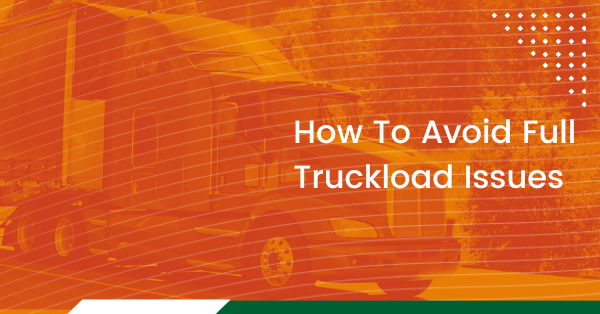The pandemic, inflation, surging product demand, and driver shortages have challenged logistics managers to discover innovative solutions. While logistics managers face many challenges, few are as crucial as full truckload shipping. Regardless of where you ship cargo, all of it goes on trucks before reaching its destinations. We will outline some common full truckload shipping issues and how to avoid them.
Full Truckload Shipping Issues
Volatility of Rates
High inflation numbers and a labor shortage are pushing rates higher. The government is tightening the money supply by raising interest rates several times this year. As a result, higher interest rates slow down the economy as mortgages and other loans consume a higher percentage of consumers’ budgets. The rate hikes reduce the demand for e-commerce, and we have already seen it happen. Amazon only reported 7.3 percent year-over-year revenue growth for the first quarter, a sign of slowing e-commerce demand. April’s CPI inflation number was 8.3 percent. Although it was slightly lower than March’s 8.5 percent reading, it is still near the 40-year high.
These developments can cool down demand and help logistics managers keep up with deliveries, but what should you do now? If a customer makes an order, you still have to deliver it. Logistics managers can raise shipping costs to help offset higher rates. Passing some of the costs to customers will increase your profitability per transaction. Some customers may walk away, but you should not deliver cargo that hurts your bottom line.
As demand cools, logistics managers should consider establishing contract prices for their freight deliveries. Contract prices provide some protection in case rates surge. You can use the contract rate within a specified timeframe instead of relying on the spot rate. Using contract rates for some deliveries protects you from rising rates while keeping money aside for spot rates lets you capitalize on short-term dips in freight rates. Rates vary for each shipper. These variances make it important to check with several solutions instead of doing all your business with a single shipper.
Knowing your profits on each order helps you establish which rates and customers you can accept. For example, you can determine if it makes sense to raise your prices to pass costs on to customers or if your profit margin is wide enough to weather the volatility of rates.
Lack of Planning
Supply chain data and developments move quickly. It’s easy to get trapped in the moment and react to what is happening. Lacking a plan can lead to emotional decision-making, worsening a tough situation. Contract rates mitigate risk by providing you with protection from rising rates. Logistics managers can explore several warehousing solutions and build new relationships. Even if you do not work with a new partner right away, expanding your network provides more choices.
Messed Inventory as a Full Truckload Shipping Issue
Building up inventory is another way to stay ahead of the curve. An ample inventory supply gives you more time to wait for attractive prices. You will not have to rush at the next available opportunity and risk paying a higher price. Scrambling to fulfill orders can also result in no openings. Other shippers can beat you to getting available FTLs due to planning further ahead. Instead, keep a shipping schedule to determine when you need to deliver freight. You can also use freight technology and apps to streamline this process.
Some logistics managers spend too much money on rates, seeking to grab every deal. These logistics managers risk overextending themselves and turning profits into losses. Consider your current commitments before spending additional money on contract and spot rates. Logistics managers can prioritize more profitable freight that can get shipped in a dry van. For example, Hazmat, reefers, and tankers have higher rates. You can also pass these costs on to customers.
Fuel Charges
Fuel charges fluctuated every week before the pandemic. Gas shortages have led to significant price hikes and narrower profits. Carriers pass the costs onto shippers, and you will have to pass these costs on to your customers. Each carrier has a different fuel surcharge policy. Base fuel rates and base fuel mileage are the two most common structures. High base rates can mean lower surcharges, but this is not always the case. Steer clear from carriers that do not explain their surcharges or try to keep them a secret. Logistics managers can choose from many carriers instead of opting for cheaper options.
Logistics managers can negotiate lower surcharges by providing carriers with higher order volumes. Carriers may make some concessions to welcome a long-term client who pays well. You should reach out to long-term partners and ask about their policies. Some carriers may have made changes due to the ongoing tension in Ukraine. Lower gas supplies have led to higher prices, but some countries are mulling if they want to tap into additional gas reserves. These developments can lead to dramatic swings in fuel prices.
Resolving Full Truckload Shipping Issues with a 3PL
Logistics managers can review their profit margins on each delivery to assess their margin of safety. Fuel charges will reduce profits and are a part of doing business. However, an excessive surcharge can wipe out your profits on the order.
Depending on profit margins and available funds, it makes sense for some shippers to explore several options. You can continue working with a third-party logistics (3PL) provider if their rates give you a wide enough profit margin. You can browse several backup choices that can provide more attractive profit margins, but it makes sense to maintain existing relationships if they are already profitable for your company. The current economic cycle has been challenging for logistics managers, but it will not be the last bump in the road. Protecting yourself and planning now will prepare you for future economic uncertainties.
Contact us today to learn more about PLS Logistics Services, we can provide quick and easy solutions for all truckload issues you may be experiencing right now.


